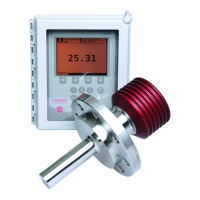4 Prism wash systems
17
4 Prism wash systems
4.1 Prism coang
Deposit build-up on the prism surface disturbs the measurement. Look out for an
abnormally high concentration reading or an upward concentration (CONC) drift.
In most applications the prism will keep clean due to the self-cleaning effect. If coating
occurs, check the following:
− Suficient low velocity, see Section 2.2.3, “Check list for pipe mounting”.
− A temperature difference between process luid and sensor probe may cause coat-
ing. This may happen with small lows if the thermal insulation is inadequate. In
some cases it helps to also insulate the clamp connector.
In case of a coating problem, the preferred solution is to try to increase the low ve-
locity, e.g. by installing a pipe portion with smaller diameter.
Installing a wash nozzle can be considered, if increasing the velocity or using a low
booster does not provide a solution (Section 4.2).
4.2 Prism wash
Three alternative media can be used for prism wash: steam, water, high pressure wa-
ter. The built-in relays of the Indicating transmitter can be conigured to control the
prism wash cycle, see Section 6.3.1, “Coniguring relays”.
Important: In food industry applications, wash media must be culinary steam or
safe water. Shut-off valve and check valve must meet 3-A sanitary standards (see Fig-
ures 4.2 and 4.5).
Culinary Steam: Shall mean steam produced using a system meeting criteria in the 3-A
Accepted Practices for a Method of Producing Steam of a Culinary Quality, Number
609.
Safe Water: Shall mean water from a supply properly located, protected, and operated,
and shall be of safe, sanitary quality. The water shall meet the standards prescribed
in the National Primary Drinking Water Regulation of the Environmental Protection
Agency (EPA) as referenced in The Code of Federal Regulations (CFR), Title 40, Parts
141, 142, and 143.

